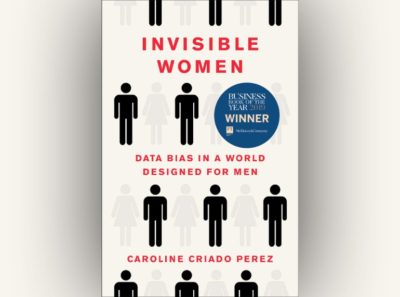
The statistics (or lack thereof) presented in this book are both fascinating, and extremely concerning at the same time. Fascinating because there are things I didn’t think of before. Such as I presumed that crash testing performed on cars would use test dummies that were of all body types, not just a typical male. Concerning because I’m curious how much more injured women get in car crashes as a result of that. Perhaps my crazy friends who refuse to wear seat belts are onto something?
I was concerned the book would be a monotonous read, but to my surprise, just the opposite. The manner in which the author presents the information is easy to read, but also very educational at the same time, which is usually my favorite type of book.
There are so many things I didn’t consider, and sadly, some things I had to nod my head in agreement to, since I am female, and I too have experienced some of what the author describes. (And for the record, all you males who like to whistle at women… imagine some dirty old man doing that to your mother, or daughter. Still think it’s cute?). More importantly, as a female scientist, I have been told on a regular basis that some male “real scientist” said x, when it turned out, that person didn’t even take biology in high school. But of course, they know more than me – after all I’m “just” a woman. That is a sad thing to experience, but it happens all too often, and this book paints this picture clearly.
Cat calling and science aside, the data in this book actually provides even deeper topics, including things I would have never considered. Some examples: restroom access design, public transportation design, and most importantly, the author made a few excellent examples of why products designed for women by women are not taken seriously by investors (at a huge loss to them I’m sure).
Now to explain why I would not give this book 5 stars. It’s actually simple. It seems the author who talks about data gaps, didn’t notice a huge gap of her own. There are two parts to this.
Part 1, includes women who don’t have children, people who have physical disabilities, and let’s not forget the men who raise children as single fathers. The book seemed to focus extensively on women who have children so much that I wondered if the author even considered that not all women have children, or that not all women raise children on their own.
Part 2 is the from the business side. While larger corporations that make millions can afford to pay for extended maternity leave, small businesses can not. There is no discussion in this book on how smaller entities are to be able to afford to pay employees such large perks. The author had an agenda of extending maternity leave for women, but never once discussed the financial burden on the side of the company, she just assumed all companies can afford to lose people for that period of time with that much pay and benefits. Not realistic. Along the same line, many of the “solutions” presented by the author involve more government spending, intervention, and regulation, and she provides few suggestions for solutions outside of that paradigm for the private sector to utilize. While more government intervention sounds like a great solution, let’s not forget which sex is the majority who still run government.
I decided that the overall information provided in this book was a good start at least, especially the information provided on unpaid women’s work. (For the record, I don’t think the author intended to imply that men never do this work, just that culturally it is work usually expected of women.) Although a good start, there is still a very long journey toward equality, including equality of product and system design. I find it disturbing that 50% of the population was never considered in the design development in most things, including healthcare. But I find it encouraging that this information is coming to light, and people are reading about it.
For Health,
Tober
Nature's Complement is a participant in the Amazon Services LLC Associates Program, an affiliate advertising program. If you purchase products on Amazon through any of our affiliate links, we get a small percentage of the transaction, at no extra cost to you. We spend a lot of time writing the articles on this site, and all this information is provided free of charge. When you use our affiliate links, you support the writing you enjoy without necessarily buying our products. (However we would appreciate if you would do that too!) Thank you for helping to support our work, however you choose to do so.
These statements have not been evaluated by the Food and Drug Administration. This information and/or products are not intended to diagnose, treat, cure or prevent any disease.


